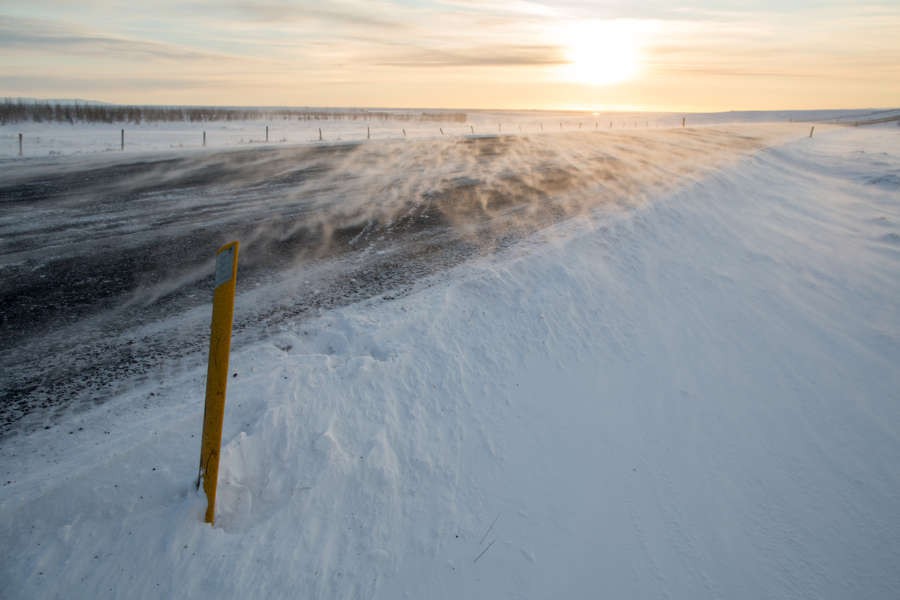Iceland is known for its fairly strong winters and abrupt changes in weather. We have a saying- ‘If you don’t like the weather, just wait five minutes.’ We are gifted with large amounts of snow and occasional storms, which is great for activities like surfing, skiing, and snowboarding. However, it can also make getting around a little dangerous in the winter. Icy roads and poor visibility are common. Another weather feature Iceland is renowned for, both in summer and winter, is the strong winds that batter the country. So, travelers to Iceland, it’s a good idea to be ready for what might await you on your Iceland adventure.
Wind Gusts in Iceland
A gust of wind may not seem like a big deal, but it can be when wind speeds are high. Generally, a mildly windy day in Iceland will have speeds of 10-15 mph (16-24 kmph) and this is really only ‘breezy’. But on some days, wind speeds in the lowlands (the ring road and coastal areas) can reach 40mph (64kmph). Gale force wind is generally considered to be speeds above that, which happens occasionally here. And rarely, the wind can be even stronger; wind speeds of over 100mph have been recorded. A single gust of wind at this speed can stop you in your walking tracks and even knock you over. In these conditions, local governments will issue weather warnings. They advise everyone to stay indoors and insist that local businesses close early so that employees can reach home safely. This happened recently and it was absolutely justified; the strong wind made it potentially dangerous to be outside. So, as a rule, if there is a storm forecast, it is best to postpone your exploration plans and have a movie day instead. The storms generally don’t last for more than a couple of days, and safety comes first.
When is it Too Windy to Drive in Iceland?
If you will be driving in Iceland, it’s worth thinking about what kind of car would be suitable for the trip you have in mind. Contact your car rental company in Reykjavik; if you are going to be driving up to the highlands, you will want a sturdy 4x4. In fact, only 4x4 vehicles are permitted to drive on the F roads that lead up to the highlands. This is because of the unpredictable weather conditions, gravel roads, and potential river crossings. When planning a trip, it is important to check the weather forecast, particularly if you are driving up to the highlands. The Icelandic Meteorological Office website can provide you with up to date forecasts, and if there is strong wind forecast it may be worth rethinking your road trip plans. Some high winds are strong enough to have your car be blown off the road. So, it is advised to not drive when wind speeds are 40mph or above, or if the Iceland Meteorological Office has issued a weather warning.

Safety Tips for windy weather
If you are on a remote highway, such as on Route 1 (the ring road), first of all, it’s very important that you don’t stop on the road. With strong wind can come bad visibility, and an approaching car may not be able to see you in time. Find a suitable rest stop if you plan to wait until the wind subsides. If you want to keep driving, keep a firm grip on the wheel and be ready for any particularly strong gusts that might shift your car. In Iceland, it is law to keep your headlights on at all times, and this is particularly important in bad weather. Keep a good distance from other vehicles, particularly larger ones such as lorries, which will be more affected by strong winds.
Additionally, regardless of when you will be traveling to Iceland, it’s advisable to always bring warm clothes whenever you venture outdoors. Iceland is not known for its warm summers; the average temperature is around 13°C in July, in the south. Wind chill is also a very real phenomenon here; the wind can make a warm day feel much colder. A,B,C- Always Bring Coats.
Camping in Iceland in high winds
For those planning on tent camping in Iceland, there are some great spots to pitch your tent and use it as your base from which to explore Iceland’s nature. In Reykjavík itself, there is Reykjavík Campsite, located on Sundlaugavegur. When you’re on your journey around the country there are plenty of other affordable campsites; there is even one at Landmannalaugar, the famous area in the highlands.

However, be aware of windy conditions. Always have your tent stakes (pegs) firmly in the ground, and cover them with some rocks if you can for extra security. If there is a storm forecast it may be worth sleeping in your car instead. As uncomfortable as it might be, you would probably struggle to get any sleep in your tent with gale-force winds blowing it back and forth. Camping trips are best reserved for June to September; with this, you have access to much more of Iceland and the likelihood of more suitable weather. The F roads, the roads that lead to the highlands, are only open from June to September anyway. Other roads in Iceland can also close if the weather is particularly bad in the winter. But as I said, a strong wind can happen at any time of the year and so it’s best to always be prepared for it.


 By
By


